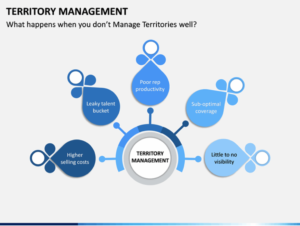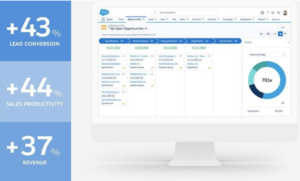Top 5 Salesforce Territory Management Best Practices to Remember
No sales manager wants to tackle assigning territories to sales reps without the proper data and tools to make the process more efficient. You must get the process right and knowing Salesforce Territory Management best practices ensure profitability.
According to Adam Gilberd, SVP of Commercial Sales at Salesforce, organizations need territory management tools to optimize their productivity for the company and the Account Executives (AE) who represent them.
Gilberd explains, “Why use data to ensure that every AE has an equal shot at quota attainment? First of all, it allows us to retain more reps. It’s very, very costly to replace a rep who’s been trained, amounting to anywhere from a half-million to a million dollars in some cases.”
He continues by outlining how this creates a more robust business. “The second reason,” he says “is that when you have balanced productivity across all of your AEs—so they’re all producing similar amounts—it’s just a healthier business.”
Before you select territories for your AEs, you must understand what Salesforce Territory Management is and the best practices to apply to your territory assignments.
What is Salesforce Territory Management?
Territory management in Salesforce is the perfect way to generate revenue. You can use territory-based sharing built on account characteristics for access and control over different account types.
Territory Management with Salesforce managed services is a way to streamline data and users linked with Salesforce in methods comparable to those correlated with other structured sales territory assignments.
If you want your team’s workload to be manageable, well-balanced, and easily manageable, establish territories for them. Factors for determining the best methods for territory assignment include:
- Sales potential
- Territory sales history
- Geography
- Sales potential
- Competitive activities
The Cost of Poor Territory Management
If your organization is not implementing a proper territory assignment method, you’re reducing your organization’s profitability. The cost of poor territory management includes:
- High selling costs: Costs per deal go up when you don’t provide your team with effective territory management. You must maximize each sales territory so that reps can close deals often, decreasing efforts wasted on looking for sales opportunities.
- Leaky talent bucket: The best territories should go to the best reps, but without knowing who is covering which territory you are not optimizing the use of top performers (aka a leaky sales bucket).
- Poor rep productivity: If a sales rep is not optimizing each hour of their day because they are roaming around aimlessly looking for a territory to sell in, they cannot be productive or efficiently close deals.
- Sub-optimal coverage: If you are not utilizing every tool possible to ensure there is excellent coverage in each area your team cannot sell effectively. Some territories may require multiple reps, and limiting coverage increased the cost per sale.
Little to no visibility: Without optimizing each territory not only do you limit your company’s visibility to your customers, but you also limit your visibility to available sales markets. Utilizing the territory management best practices ensures clear visibility is available to prospects, AEs, and yourself as the sales manager.
5 Salesforce Territory Management Best Practices
Here are the top five best practices for integrating Salesforces Territory Management within your organization:
1. Assign Territories Based on Organizational Goals
The first of the Salesforce Territory Management best practices is to consider the market approach of your organization and its overall company goals. Think about what factors will shape the growth of your organization in the following 5 years.
2. Use Multiple Factors in Your Formula
You cannot base territory assignment on only one factor, such as zip codes. Doing this doesn’t provide the same opportunities or utilize high performers in the most valuable territories. The best approach is to include the following in your territory assignment formula:
- Total number of companies
- Size of companies by number of employees or yearly revenue
- Inclination to purchase
- Types of industry
- Geography and topography
3. Determine Territory & Role Hierarchies
Not only will you be assigning territories with Salesforce Territory Management, but you will also be able to grant access to specific roles. For example, you can allow AEs and managers different levels of permissions. You will also provide a higher level of security by restricting access to specific users.
4. Develop Lead Assignment Guidelines
By establishing rules for assigning territories, you streamline the entire process and improve performance and productivity. For example, if a rep would be better suited for speaking to specific prospects, lead assignment guidelines will help you make that determination based on performance records.
5. Provide Consistent Training
Lastly, you must ensure that every rep receives the training they need to properly utilize the territory management tools available to them. In doing this, you make sure each AE is getting the most out of the Salesforce Territory Management platform.
Benefits of Using Territory Management with Salesforce
Utilizing all of the Salesforce tools within your organization optimizes lead conversion by 43% and sales productivity by 44%. Yet, productivity is just one of the advantages of Salesforce Territory Management. Here are the top benefits to consider:
- Logical routing: Your team can map out their day to maximize every opportunity within that designated territory. It allows them to visualize where to focus their efforts.
- Custom Assignments: You can award the most valuable territories to high-performers and give learning opportunities to new AEs by assigning them fewer challenging opportunities.
- Performance Metrics: Visualizing data gives sales managers an effortless way to see the performance of each sales rep and their territories. You get metrics and reports that allow you to optimize each area.
Are You Ready to Optimize Your Salesforce Territory Management Strategy? Rainmaker Can Help
At Rainmaker, our Salesforce Managed Services offers a pro-active consulting service intended to facilitate the Salesforce innovation journey while maximizing ROI for our clients. The company will work closely with you and your team, providing best practices that help businesses optimize automation for success in a dynamic environment.
Rainmaker helps you integrate Salesforce into your organization’s workflow to make territory management a bit easier. Speak to one of our knowledgeable Salesforce consultants today.








